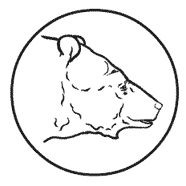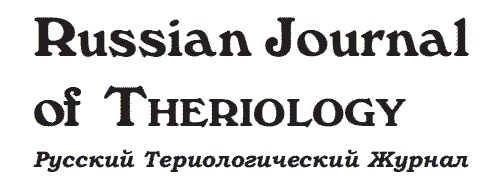The first record of Amphimachairodus horribilis from the Late Miocene of Mongolia
Sotnikova M.V., Sizov A.V.
P. 65-79
Mandibular fragments of a large-sized sabre-toothed cat from the Late Miocene (MN12/MN13) of the locality Khyargas Nuur 2 (=Khirgis-Nur-2) in northwestern Mongolia are described. They are included in the hypodigm of the species Amphimachairodus horribilis, a common member of the Late Turolian (Late Baodean) fauna of Central Asia and China. The attribution to this species is based on the large size of the cheek teeth, the presence of slight serrations along their cristids, and the morphology of the metaconid-talonid complex on m1, with a slender, cutting, ventrally rounded, and well-differentiated metaconid, as seen in the lectotype of A. horribilis. Comparative analysis of the Mongolian remains and the morphologically close Amphimachairodus irtyshensis, from the nearby locality of Pavlodar (MN12) in Kazakhstan, suggested that the latter taxon is an independent, relatively more primitive species, rather than a synonym of more advanced A. horribilis. This is the first report of A. horribilis from Mongolia and, so far, the northernmost occurrence of this species in Eurasia. This work also reconsiders the phylogeny of Eurasian representatives of Amphimachairodus.
DOI: 10.15298/rusjtheriol.24.1.09References- Antón M., Salesa M.J., Morales J. & Turner A. 2004. First known complete skulls of the scimitar-toothed cat Machairodus aphanistus (Felidae, Carnivora) from the Spanish late Miocene site of Batallones-1 // Journal of Vertebrate Paleontology. Vol.24. No.4. P.957–969. DOI:10.1671/0272-4634(2004)024[0957:FKCSOT]2.0.CO;2
- Antón M., Salesa M.J. & Siliceo G. 2013. Machairodont adaptations and affinities of the Holarctic late Miocene homotheriin Machairodus (Mammalia, Carnivora, Felidae): the case of Machairodus catocopis Cope, 1887 // Journal of Vertebrate Paleontology. Vol.33. No.5. P.1202–1213. DOI:10.1080/02724634.2013.760468
- Beaumont G. de. 1975. Recherches sur les Félidés (Mammifères Carnivores) du Pliocène inférieur des sables à Dinotherium des environs d’Eppelsheim (Rheinhessen) // Archives des Sciences Physiques et Naturelles, Genève. Vol.28. P.369–405.
- Deng T., Zhang Y.X, Tseng Z.J. & Hou S.K. 2016. A skull of Machairodus horribilis and new evidence for gigantism as a mode of mosaic evolution in machairodonts (Felidae, Carnivora) // Vertebrata PalAsiatica. Vol.54. No.4. P.302–318.
- Devyatkin E.V. & Zhegallo V.I. 1974. [New data on the locations of Neogene faunas of Northwestern Mongolia: (On the issue of identifying a stratotype region for the Neogene of Central Asia)] // Fauna and biostratigraphy of the Mesozoic and Cenozoic of Mongolia. Moscow: Nauka. P.330–356 [in Russian].
- Devyatkin E.V. 1981. [The Cenozoic of Inner Asia: Stratigraphy, geochronology, correlation]. The Joint Soviet-Mongolian Scientific-Research Geological Expedition, Transactions 27. Moscow: Nauka. 196 p. [in Russian].
- Dmitrieva E.L. 1977. [Neogene antelopes of Mongolia and adjacent territories]. Trudy Soviet Mongolian Palaeontological Expedition. No.6. Moscow: Nauka. 120 p. [in Russian].
- Forsten A. 1997. A review of Central Asiatic hipparions (Perissodactyla, Equidae) // Acta Zoologica Fennica. No.205. P.1–26.
- Godina A.Y. 1974. [On new finds of giraffes of the genus Samotherium from Neogene deposits of Western Mongolia] // [Fauna and biostratigraphy of the Mesozoic and Cenozoic of Mongolia]. Proceedings of the SSMPE. No.1. Moscow: Nauka. P.87–90 [in Russian].
- Jiangzuo Q., Werdelin L. & Sun Y. 2022 A dwarf sabertooth cat (Felidae: Machairodontinae) from Shanxi, China, and the phylogeny of the sabertooth tribe Machairodontini // Quaternary Science Reviews. Vol.284. P.1–19. DOI:10.1016/j.quascirev.2022.107517.
- Kaakinen A., Passey B.H, Zhang Z.Q., Liu L.P., Pesonen L.J. & Fortelius M. 2013. Stratigraphy and paleoecology of the classical dragon bone localities of Baode County, Shanxi Province // Wang Х., Flynn L.J. & Fortelius M. (eds.). Fossil mammals of Asia. New York: Columbia University Press. P.203–217.
- Kretzoi M. 1929. Materialen zur phylogenetischen klassifikation der Aeluroideen // 10th International Zoological Congress. Budapest. P.1293–1355.
- Kurtén B. 1976. Fossil Carnivora from the late Tertiary of Bled Douarah and Cherichira, Tunisia // Notes du Service Géologique de Tunisie. Vol.42. P.177–214.
- Martin L., Babiarz J., Naples V. & Hearst J. 2000. Three ways to be a sabre-toothed cat // Naturwissenschaften. Vol.87. P.41–44. DOI:10.1007/s001140050007
- McKenna M.C. & Bell S.K. 1997. Classification of Mammals above the Species Level. New York: Columbia University Press. 631 p.
- Morales J. 1984. Venta del Moro: su macrofauna de mamíferos y bioestratigrafía continental del Mioceno mediterráneo. PhD Dissertation. Madrid: Universidad Complutense de Madrid. 351 p.
- Morlo M. & Semenov Y. 2004. New dental remains of Machairodus Kaup, 1833 (Felidae, Carnivora, Mammalia) from the Turolian of Ukraine: significance for the evolution of the genus // Kaupia, Darmstädter Beiträge zur Naturkunde. Vol.1. P.123–138.
- Orlov J.A. 1936. Tertiäre Raubtiere des westlichen Sibiriens. 1. Machairodontinae. // Proceedings of the Palaeozoological Institute of the USSR Academy of Sciences. Vol.5. P.111–152.
- Peigné S., de Bonis L., Likius A., Mackaye H.T., Vignaud P. & Brunet M. 2005. A new machairodontine (Carnivora, Felidae) from the Late Miocene hominid locality of TM266, Toros-Menalla, Chad // Comptes Rendus Palevol. Vol.4. P.243–253. DOI:10.1016/j.crpv.2004.10.002
- Qiu Z.X., Shi Q.Q. & Liu J.Y. 2008. Description of a skull material of Machairodus horribilis Schlosser, 1903 // Vertebrata PalAsiatica. Vol.46. No.4. P.265–283.
- Riabinin A. 1929. [Taraklian fauna of mammals. 1. Carnivora vera, Rodentia, Subungulata] // Travaux du Musée Géologique près l’Académie des Sciences de l’URSS. Vol.5. P.75–134 [in Russian].
- Roussiakis S.J. & Theodorou G.E. 2003. Carnivora from the Late Miocene of Kerassiá (Northern Euboea, Greece) // Deinsea. No.10. P.469–497.
- Schlosser M. 1903. Die Fossilen Säugethiere Chinas nebst einer Odontographie der recenten Antilopen // Abhandlungen der Bayerischen Akademie der Wissenschaften. Vol.22. P.1–221.
- Sizov A.V., Sotnikova M.V., Sokolov S.A., Yakimova A.A., Tesakov A.S., Vislobokova I.A., Zelenkov N.V., Simakova A.N., Yushin K.I. & Batsaikhan Tserenpil. 2024. [A new perspective on the age and geological structure of the Neogene vertebrate locality Khyargas Nuur 2 (northwestern Mongolia)] // Geodynamics & Tectonophysics. Vol.15. No.6. P.0791 [in Russian]. DOI:10.5800/GT-2024-15-6-0791
- Sotnikova M.V. 1992. A new species of Machairodus from the late Miocene Kalmakpai locality in eastern Kazakhstan (USSR) // Annales Zoologici Fennici. Vol.28. P.361–369.
- Sotnikova M. & Rook L. 2010. Dispersal of the Canini (Mammalia, Canidae: Caninae) across Eurasia during the Late Miocene to Early Pleistocene // Quaternary International. Vol.212. No.2. P.86–97. DOI:10.1016/j.quaint.2009.06.008.
- Sotnikova M.V. & Tleuberdina P.A. 2023. [On the finds of representatives of the subfamily Machairodontinae (tribe Homotheriini) in the late Miocene of the Republic of Kazakhstan] // [Zoological research in Kazakhstan in the XXI century: results, problems and prospects]. Articles of the International Scientific Conference dedicated to the 90th anniversary of the Institute of Zoology of the Republic of Kazakhstan.13–16 April 2023, Almaty. P.913–919 [in Russian].
- Turner A. & Antón M. 1997. The Big Cats and their Fossil Relatives. New York: Columbia University Press. 234 p.
- Vangengeim E.A., Vislobokova I.A., Godina A.Ya., Dmitrieva E.L., Zhegallo V.I., Sotnikova M.V. & Tleuberdina P.A. 1993. On the Age of Mammalian Fauna from the Karabulak Formation of the Kalmakpai River (Zaisan Depression, Eastern Kazakhstan) // Stratigraphy and Geological Correlation. Vol.1. No.2. P.38–45.
- Vislobokova I.A. 1983. [The fossil deer of Mongolia]. [Trudy Soviet Mongolian Palaeontological Expedition, 23]. Moscow: Nauka. 79 p. [in Russian].
- Wagner A. 1848. Urweltliche Säugethierreste aus Griechenland // Abhandlungen der Bayerischen Akademie der Wissenschaften, Mathematisch-Physikalische Klasse. München. Vol.5. P.333–378.
- Wang X., Carranza-Castañeda O. & Tseng Z.J. 2023. Fast spread followed by anagenetic evolution in Eurasian and North American Amphimachairodus // Historical Biology. Vol.35. No.5. P.780–798. DOI:10.1080/08912963.2022.2067756
- Werdelin L. 2003. Mio-Pliocene Carnivora from Lothagam, Kenya // Leakey M.G. & Harris J.M. (eds.). Lothagam — The Dawn of Humanity in East Africa. New York: Columbia University Press. P.261–328. DOI:10.7312/leak11870-013
- Werdelin L., Yamaguchi N., Johnson W.E. & O’Brien S.J. 2010. Phylogeny and evolution of cats (Felidae) // Macdonald D.W. & Loveridge A.J. (eds.) Biology and conservation of wild felids. Oxford: Oxford University Press. P.59–82.
- Zdansky O. 1924. Jungtertiäre Carnivoren Chinas // Palaeontologica Sinica, Series C. Vol.2. No.1. P.1–149.
Download PDF
|

